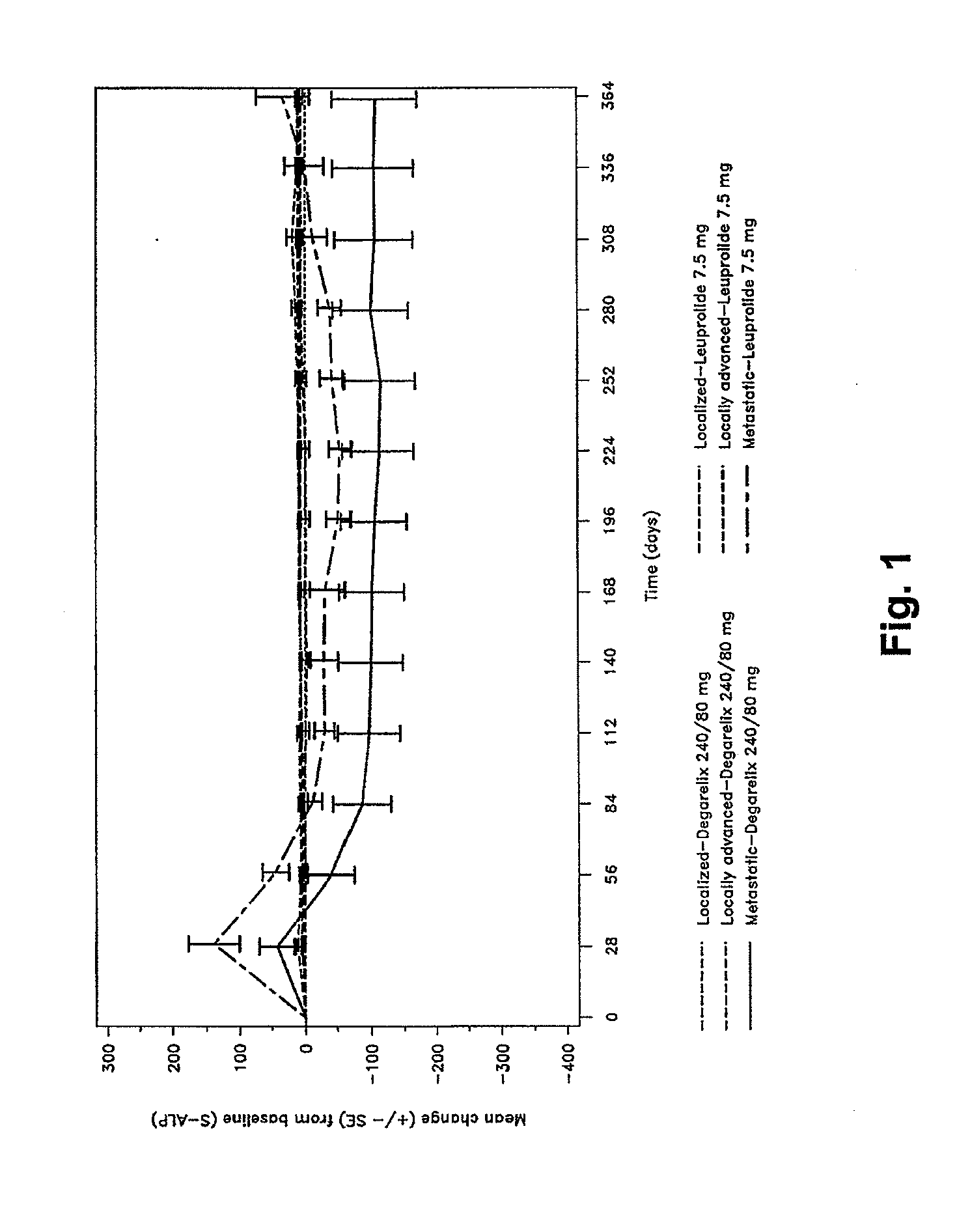Method of treating metastatic stage prostate cancer
a prostate cancer and metastatic stage technology, applied in the direction of drug compositions, pharmaceutical delivery mechanisms, peptide/protein ingredients, etc., can solve the problem of delay in the progression to the hormone refractory stage, and achieve the effect of reducing the serum alkaline phosphatase (s-alp)
- Summary
- Abstract
- Description
- Claims
- Application Information
AI Technical Summary
Benefits of technology
Problems solved by technology
Method used
Image
Examples
example 1
S-ALP Levels in Prostate Cancer Patients Treated with Degarelix Versus Leuprolide
[0089]Example 1 gives the results of the analyses of serum alkaline phosphatase (S-ALP) performed on patients undergoing treatment for prostrate cancer, using alternatively, degarelix (240 / 80 mg) and leuprolide (7.5 mg) treatments.
Methods:
[0090]Patients with histologically confirmed adenocarcinoma of the prostate (all stages), for whom androgen deprivation therapy was indicated were recruited. Baseline characteristics were well balanced between groups. Approximately half of patients had locally advanced (29.2%) or metastatic (20.5%) disease at baseline. A total of 610 patients (mean age 72 years, median testosterone was 39.3 ng / mL, and median PSA 19.0 ng / mL) were randomized to 1 of 3 dosing regimens: degarelix s.c. 240 mg for 1 month (initiation dose) followed by monthly maintenance doses of 160 mg (n=202) or 80 mg (n=207), or monthly intramuscular injections of leuprolide depot 7.5 mg (n=201). Patients...
example 2
PSA Failure in Prostate Cancer Patients Treated with Degarelix Versus Leuprolide
[0099]This example provides additional PSA level analyses from the phase III clinical trial CS21 (described herein), which examined the efficacy and safety of degarelix compared with leuprolide over 12 months of prostate cancer treatment. In particular, analysis of a secondary endpoint termed PSA failure revealed a surprisingly advantageous effect of degarelix treatment as compared to leuprolide treatment, particularly for patients with metastatic stage prostate cancer.
[0100]Prostate-specific antigen (PSA) is a commonly used marker in the diagnosis of prostate cancer and has more recently also been used to monitor response to treatment as well as disease recurrence and progression (Fleming et al. (2006) Nat. Clin. Pract. Oncol. 3: 658-67; Lilja, et al. (2008) Nat. Rev. Cancer 8: 268-78). In general, higher levels of PSA are associated with more severe forms of prostate cancer, with metastatic stage prost...
example 3
Clinical Study of Degarelix for the Treatment of Prostate Cancer
[0105]In this example, an open-label, multi-center, randomized, parallel-group study was conducted to investigate the efficacy and safety of degarelix one month dosing regimens using either of two different once-a-month dosing regimens, 160 mg (40 mg / mL) or 80 mg (20 mg / mL). These degarelix dosing regimens were compared to leuprolide at 7.5 mg in patients with prostate cancer requiring androgen ablation therapy.
[0106]The study also investigated whether degarelix is safe and effective with respect to achieving and maintaining testosterone suppression to castrate levels, evaluated as the proportion of patients with testosterone suppression ≦0.5 ng / mL during 12 months of treatment. The study assessed serum levels of testosterone and prostate-specific antigen (PSA) during the first 28 days of treatment using a degarelix dosing regimen as compared to leuprolide 7.5 mg. The study further compared the safety and tolerability u...
PUM
| Property | Measurement | Unit |
|---|---|---|
| molecular weight | aaaaa | aaaaa |
| concentration | aaaaa | aaaaa |
| concentration | aaaaa | aaaaa |
Abstract
Description
Claims
Application Information
 Login to View More
Login to View More - R&D
- Intellectual Property
- Life Sciences
- Materials
- Tech Scout
- Unparalleled Data Quality
- Higher Quality Content
- 60% Fewer Hallucinations
Browse by: Latest US Patents, China's latest patents, Technical Efficacy Thesaurus, Application Domain, Technology Topic, Popular Technical Reports.
© 2025 PatSnap. All rights reserved.Legal|Privacy policy|Modern Slavery Act Transparency Statement|Sitemap|About US| Contact US: help@patsnap.com



